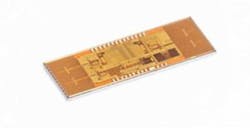Radar, once the domain of military/ aerospace applications, weather forecasting, and other specialized areas, is becoming ubiquitous. The phrase “automotive radar” no longer brings to mind only the dreaded police speed gun. A recent innovation from imec promises to move radar ever further into our daily lives. Meanwhile, advanced radar systems in traditional military and aerospace applications are presenting growing test and measurement challenges.
140-GHz CMOS SoC
At the International Microwave Symposium in June in Philadelphia, imec presented what it called the world’s first CMOS 140-GHz SoC with integrated antennas in standard 28-nm technology (Figure 1). The organization called the achievement an important step in the development of radar-based contactless sensors for myriad smart intuitive applications: people detection and classification, vital-signs monitoring, and gesture interfacing, to name a few. The device offers the necessary high resolution, compact size, power efficiency, and low cost necessary to drive wide adoption, imec reported.
The imec device comprises an imec proprietary 2-antenna SISO (single-input, single-output) radar transceiver chip and a frequency-modulated continuous-wave phase-locked
loop (FMCW PLL) plus off-the-shelf ADCs and an FPGA. The transceiver features on-chip antennas achieving a gain close to 3 dBi. Transmitter effective isotropic radiated power (EIRP) that exceeds 9 dBm and a receiver noise figure below 6.4 dB help support the radar link budgets. The total power consumption for transmitter and receiver remains below 500 mW, which can be further reduced by duty-cycling. The FMCW PLL enables fast slopes up to 500 MHz/ms over a 10-GHz bandwidth around 140 GHz with a slope linearity error below 0.5%, and it has a power consumption below 50 mW. The FPGA contains a real-time implementation of basic radar processing functions such as FFTs and filters and is complemented by Matlab processing for detections, CFAR (constant false alarm rate) calculations, direction-of-arrival estimation, and other advanced radar functions.
“With our prototype radar, we have demonstrated all critical specs for radar technology in 28-nm standard CMOS technology,” said Wim Van Thillo, IoT program director at imec, in a press release. “We are well advanced in incorporating multiple antenna paths in our most recent generation solution, which will enable a fine angular resolution of 1.5 cm in a complete MIMO radar form factor of only a few square centimeters. We expect this prototype in the lab by the end of 2018, at which point our partners can start building their application demonstrators. First applications are expected to be person detection and classification for smart buildings, remote car-driver vital-signs monitoring (as cars evolve toward self-driving vehicles), and gesture recognition for intuitive man-machine interactions. Plenty more innovations will be enabled by this technology, once app developers start working with it.”
This imec 140-GHz radar open innovation R&D collaborative program has been endorsed by Panasonic, and imec invites potentialy interested parties to join.
Radar test challenges
For devices like the imec SoC to come to market to serve myriad potential applications areas for radar in everyday life, test challenges related to cost and throughput will ultimately need to be solved. Meanwhile, advanced radar systems in military and aerospace application areas are already presenting test challenges. Walt Strickler, vice president and general manager for Wireless Telecom Group’s Boonton business, commented, “Testing radar signals has never been more demanding. New and increasing threats abroad require long-range visibility and corresponding wide radar pulse widths and long pulse repetition intervals, while the increase in urban warfare demands narrow radar pulse widths and high pulse repetition frequencies to detect small, close threats.”
The challenges don’t stop there. “In parallel, budgets continue to get squeezed,” Strickler said. “Engineers are faced with trying to cut costs while ensuring that valuable investments give them flexibility for future requirement changes. All this occurs in the face of ever-increasing competition, demanding greater quality products to stay ahead of competitors.”
Boonton helps customers meet such challenges with technology such as its trademarked Real-Time Power Processing feature, which is incorporated in the company’s recently introduced Model 4500C peak power analyzer. The 4500C minimizes the likelihood of missing pulses or intermittent events in radar and related applications.
Matt Diessner, director, business development for Wireless Telecom Group’s Boonton and Noisecom businesses, said that Noisecom complements Boonton Electronics with products that can be used in radar test applications to provide real-world interference to determine a system’s robustness in the face of jamming or countermeasure signals being sent to it.EE


